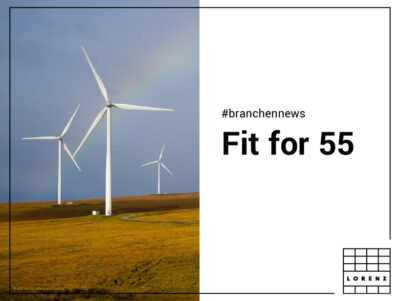EU Fit for 55: Ambitious measures for climate neutrality

The EU wants to become climate-neutral by 2050. This is an ambitious goal that requires ambitious measures. In order not to jeopardize the goal of climate neutrality, the EU has now presented “Fit for 55,” a comprehensive package of measures.
Table of Contents
- What does Fit for 55 mean?
- The cornerstones of the Fit for 55 package
- Impact of the Fit for 55 package on the building sector
- Fit for 55: What’s next?
What does Fit for 55 mean?
Fit for 55 is a package of measures developed by the EU to implement the Green Deal. The major goal is climate neutrality by 2050.
With this program, the European Commission is proposing a realignment of the economy and society within the EU so that the climate targets can be achieved.
For the green transition to succeed, EU legislation must be adapted. The package includes a number of proposals to ensure that the EU’s commitment to climate neutrality and key milestones are not jeopardized. The Fit for 55 proposals now create a balanced framework for achieving the ambitious targets.
Why is it called “Fit for 55”?
The name Fit for 55 refers to the EU’s goal of reducing net greenhouse gas emissions by at least 55 percent from 1990 levels by 2030. The new climate law makes reducing emissions a legal obligation.
Background: Green Deal
.
The so-called European Green Deal was unveiled in 2019. The plan is to make Europe the first climate-neutral continent by 2050. It aims to make the transition to a modern, resource-efficient and competitive economy and leave a healthy continent for future generations.
Reading Tip: Climate-friendly construction should pay off from now on. The federal funding for efficient buildings (BEG) has been restructured. You can find all the information in this article.
The cornerstones of the Fit-for-55 package
.
The Fit-for-55 climate plan is a collection of different measures targeting different areas. In the following, we would like to briefly present the most important cornerstones of the package.
Tightening the emissions trading system
.
Emissions trading is considered one of the central instruments for reducing greenhouse gas emissions. The current reduction target will be tightened – from 43 percent to 62 percent compared to 2005 levels.
This means that emission rights will be cut even more in order to achieve the reduction target. In order to implement the ambitious targets, the budget for emission allowances will be reduced in the future, free allowances will be phased out and new sectors will be included in emissions trading.
Emissions trading for transport and buildings
Greenhouse gases must be saved in the transport and buildings sectors. A new emissions trading system is therefore to be created for these two sectors from 2027.
To this end, CO2 allowances are to be freely traded. Free certificates for market participants will be dispensed with. You will find out in the further course what effects this innovation will have on the building sector.
Climate Social Fund
.
EU member states are bearing the burdens associated with climate targets. A newly created Climate Social Fund is intended to alleviate the burdens of the new emissions trading system for buildings and transport.
The fund will allow member states to provide support measures and investments for those most affected by price increases.
CO2 Boundary Adjustment Scheme
.
Under “Fit for 55,” a CO2 border adjustment system will be created to prevent carbon emissions from being shifted to other countries.
Companies from non-EU countries are subject to less stringent emissions rules and thus face fewer additional costs. A CO2 price is therefore levied on imported goods such as cement, steel or aluminum.
This ensures equal treatment of EU companies and importers as well as the competitiveness of European companies.
Increasing energy efficiency
.
To meet climate targets, EU countries must use their energy more efficiently. A new energy efficiency directive aims to sharply reduce energy consumption by 2030 compared with 2020 (by at least 9 percent).
EU member states will thus have to increase their annual energy-saving commitments by almost double.
Additional measures
Further extensive measures were presented as part of the Fit for 55 package. These include, for example
- Acceleration of the expansion of renewable energies
- 100% CO2-free new cars as of 2035
- Update of the load distribution ordinance
- Development of infrastructure for alternative fuels, etc.
Reading Tip: If you want more comprehensive information on the individual proposals of the package of measures, you will find on the page of the European Council more information.
Impact of the Fit for 55 package on the building sector

The building sector is facing far-reaching changes as part of “Fit for 55”. The overarching goal of reducing greenhouse gases is to be supported by two specific measures:
- Extension of emissions trading to buildings
- Adaptation of the Directive on the Energy Efficiency of Buildings
Below, we take a closer look at the two measures.
Emissions trading for the buildings sector
.
Emissions trading is one of the most important levers for slowing global warming. This instrument remains a key component of the Fit for 55 climate package.
Emissions trading in its current form only applies to energy companies, energy-intensive industries and parts of the aviation sector. A new emissions trading system for buildings and other sectors is to be implemented from 2027.
Background: how does emissions trading work?
Emissions trading is used to limit greenhouse gas emissions to a level necessary to meet climate targets. Emission allowances are issued, which market participants can buy at auction. CO2 can only be emitted with these emission certificates.
This gives CO2 a price that emitters have to pay. The fewer emission certificates there are, the more the price rises. The idea behind this: Market participants are encouraged to use more climate-friendly technologies.
In contrast to government intervention, the reduction of CO2 emissions is not achieved through bans or regulations, but through free competition. Participants that are particularly innovative or reduce their emissions faster can in turn sell emission rights.
Part of the revenue from EU emissions trading will go into an innovation fund to promote investment in climate-friendly technologies.
Effects on the buildings sector
.
With the EU-wide extension of emissions trading to the sector, CO2 emissions will be priced. Anyone who causes emissions must pay this price.
In Germany, national emissions trading has already been in place for the buildings and transport sectors since 2021. Companies that put heating and fuel into circulation must pay a CO2 price. The additional costs are passed on to citizens. The CO2 price makes fossil heating and fuels more expensive.
To ensure that prices for end consumers in general do not rise too sharply, certificate prices are cushioned and a climate social fund is set up.
Reading tip: In this article we introduce the European showcase project with LORENZ modules from Oberhausen.
Adaptation of the Energy Performance of Buildings Directive
.

In the EU, the building sector accounts for more than one-third of greenhouse gas emissions. 75 percent of existing buildings are not energy efficient. Increasing energy efficiency or reducing energy consumption in this sector is therefore crucial to achieving climate targets.
The new Directive on the Energy Performance of Buildings in the EU sets out new standards for new and renovated buildings. By 2050, all buildings in the EU are to be so-called zero-emission buildings.
Implications for new buildings
.
Under the new directive, all buildings owned by public institutions must be zero-emission from 2028. From 2030, this will apply to all newly constructed buildings. Also from 2030, energy performance certificates will be mandatory.
Impact on existing buildings
.
The area of existing buildings will be subdivided once again into non-residential and residential buildings.
For non-residential buildings, the individual EU member states must set minimum energy performance targets. This means setting a maximum amount of energy that buildings can consume per square meter per year.
In the case of residential buildings, a staggered approach to the minimum targets for average primary energy consumption occurs over time. By 2033, all buildings must be at the level of energy performance class D. By 2040, member states are to set the energy level to ensure that by 2050 all buildings are so-called zero-emission buildings.
Exceptions apply to:
- Historical buildings
- Buildings for religious purposes
- Buildings for defense purposes
- Industrial facilities, workshops and agricultural buildings
- Free-standing buildings with less than 50 m2
What are zero-emission buildings?
Zero-emission buildings, as defined by the directive, are buildings with a very high energy performance. They record no or very low energy demand. This is completely covered by energy from renewable sources without CO2 emissions from fossil fuels, as far as this is technically feasible.
Reading Tip: LORENZ assembly systems made of wood and straw are climate positive. All background information on the LCA study can be found in this article.
Energy supply for buildings
.
The new policy under Fit for 55 also requires all new public buildings and non-residential buildings to be equipped with solar panels from 2027. The same will apply to all existing public buildings undergoing renovation from 2028 and to all new residential buildings from 2030.
Fit for 55: What’s next?
With the Fit for 55 package, the EU Commission, in consultation with the European Council and the European Parliament, has presented a comprehensive package of measures for achieving European climate neutrality in 2050.
The EU is thus setting the course for achieving the ambitious climate target and providing the member states with a regulatory framework for implementation.
However, the reform project must first be approved by the member states.
FAQ – Frequently asked questions about “Fit for 55”
What does “Fit for 55” mean?
“Fit for 55” refers to a package of measures by the EU Commission to reduce EU-wide greenhouse gas emissions by 55 percent by 2030 compared to 1990 levels.
What innovations does the Fit for 55 package include?
The Fit for 55 package includes a wide range of proposals for measures to achieve the EU’s climate target. Among the key cornerstones are the
- Tightening of the emissions trading system
- Extension of emissions trading to the transport and buildings sectors
- Establishment of a climate social fund
- Introduction of a CO2 limit compensation system
- Increasing energy efficiency
The most important information on these measures can be found in our article.
What impact will “Fit for 55” have on the building sector?
Far-reaching changes are coming to the buildings sector with the introduction of a new emissions trading scheme and the revision of the Energy Efficiency Directive for Buildings. Starting in 2027, emissions allowances will be traded across the EU in this sector. In addition, the requirements for the energy efficiency of buildings will be tightened. From 2050, all buildings are to be so-called zero-emission buildings. You can find out more about this in the article.



